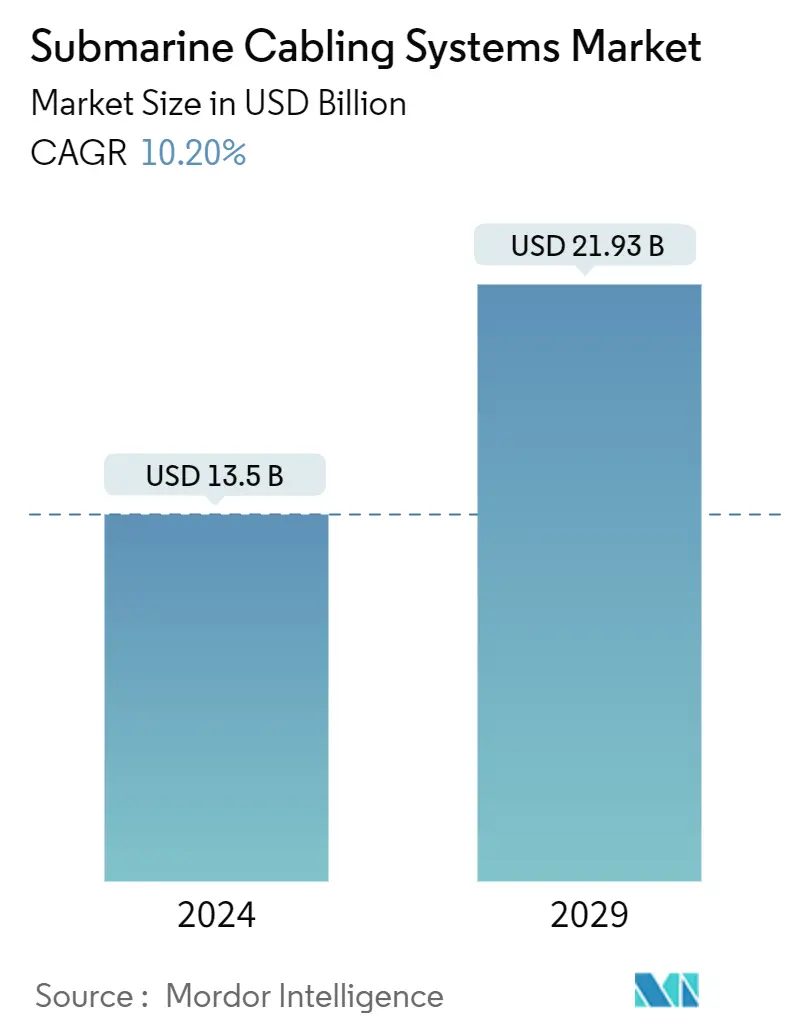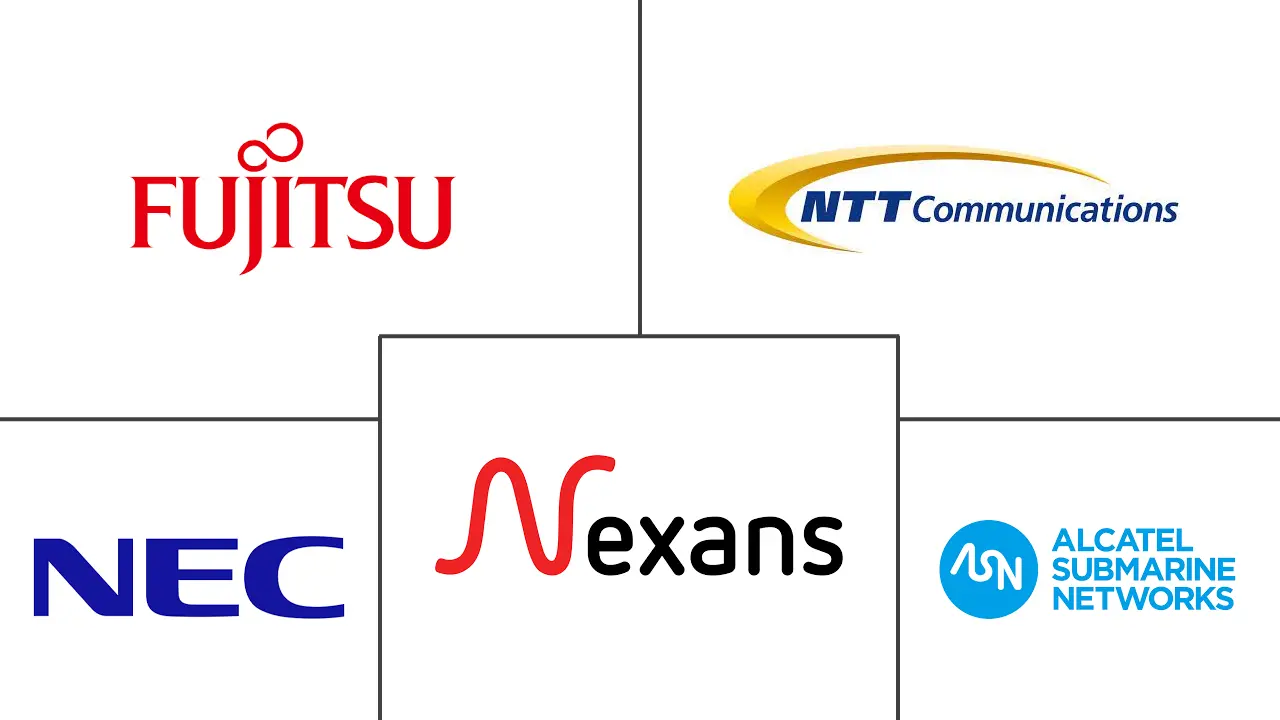Market Size of Submarine Cabling Systems Industry

| Study Period | 2019 - 2029 |
| Base Year For Estimation | 2023 |
| Market Size (2024) | USD 13.5 Billion |
| Market Size (2029) | USD 21.93 Billion |
| CAGR (2024 - 2029) | 10.20 % |
| Market Concentration | Low |
Major Players
*Disclaimer: Major Players sorted in no particular order |
Submarine Cabling Systems Market Analysis
The Submarine Cabling Systems Market size is estimated at USD 13.5 billion in 2024, and is expected to reach USD 21.93 billion by 2029, growing at a CAGR of 10.20% during the forecast period (2024-2029).
- Submarine cable systems typically utilize optical fiber cables for transmitting both data and power. These systems are laid on the seabed, connecting cable landing stations (CLS) at different locations to carry telecommunication and power signals across vast expanses of the ocean. Submarine cabling systems offer highly reliable, secure, and high-capacity telecommunication links between countries worldwide.
- One primary factor driving the growth of the submarine cabling system market is the increased investment in high-speed internet infrastructure. Additionally, the continuous expansion in data generation and transmission globally is anticipated to significantly boost market growth. Consequently, numerous internet backbone operators are expected to invest in the submarine cabling system market throughout the forecast period.
- As Internet access expands in developing countries, the next phase of network improvement may focus on emerging markets worldwide. Consequently, many businesses, including government entities, perceive the submarine cabling system market as a lucrative prospect. Moreover, the rapid increase in mobile broadband adoption significantly contributes to industry growth.
- Furthermore, the global demand for smartphones has been on the rise due to various factors, including increasing disposable income, the introduction of 5G, and telecom infrastructure advancements. Ericsson reports that the global number of smartphone subscribers was 6.26 billion in 2021, predicted to reach 7.69 billion in 2027. These trends are expected to remain key drivers of the studied market’s growth.
- Submarine cables, crucial to the global economy and telecommunications, operate in an environment increasingly exposed to geopolitical, physical, and cyber threats, including nation-state sabotage and spying. According to official sources, submarine communication cables are a growing target for cyber-threat actors, with incidents capable of causing substantial global internet disruption, further impacting the studied market's growth.
Submarine Cabling Systems Industry Segmentation
Submarine cables are fiber optic connections that connect countries worldwide by placing cables beneath the ocean. These thousands of kilometers-long cables can instantly transport large volumes of data from one site to another. A specialized ship is used to aid in the installation of these lines. Submarine cable networks are striving to reach previously undiscovered areas.
The submarine cable systems market is segmented by type, ownership type, and geography. By type, the market is segmented into dry plant products and wet plant products. By ownership type, the market is segmented into multiple ownership systems, single ownership systems, and multilateral development banks. The market is segmented by geography into Trans-Pacific, Trans-Atlantic, US-Latin America, Intra Asia, Europe-Asia, and Europe-Sub-Saharan Africa.
The report offers market forecasts and size in value (USD) for all the above segments.
| By Type | |
| Dry Plant Products | |
| Wet Plant Products |
| By Ownership Type | |
| Multiple Ownership System | |
| Single Ownership System | |
| Multilateral Development Banks |
| By Geography | |
| Trans - Pacific | |
| Trans - Atlantic | |
| US - Latin America | |
| Intra Asia | |
| Europe - Asia | |
| Europe - Sub-Saharan Africa |
Submarine Cabling Systems Market Size Summary
The submarine cabling systems market is poised for significant growth, driven by the increasing demand for high-speed internet infrastructure and the expansion of data transmission capabilities worldwide. These systems, which utilize optical fiber cables to transmit data and power across oceanic distances, are essential for providing reliable and secure telecommunication links between countries. The market is experiencing a surge in investment as internet backbone operators seek to enhance connectivity, particularly in developing regions where internet access is rapidly expanding. The proliferation of mobile broadband and the rising global demand for smartphones, fueled by advancements in telecom infrastructure and the introduction of 5G, are further propelling the market's expansion. However, the industry faces challenges from geopolitical, physical, and cyber threats, which pose risks to the integrity and security of submarine cables.
The market landscape is characterized by the involvement of key players such as NTT Communications Corporation, Nexans SA, Fujitsu Ltd, NEC Corporation, and Alcatel Submarine Networks, who are actively engaging in strategic partnerships and initiatives to strengthen their market presence. Notable projects include the development of extensive trans-Pacific and transatlantic cable systems, which aim to enhance digital connectivity and resilience across regions. The Asia-Pacific region, contributing significantly to global internet traffic, is a focal point for new cable installations, supported by funding from international organizations. As countries like Japan and Australia intensify their investments in submarine cable networks, the market is set to benefit from increased economic growth and digital infrastructure development.
Submarine Cabling Systems Market Size - Table of Contents
-
1. MARKET INSIGHTS
-
1.1 Market Overview
-
1.2 Industry Attractiveness - Porter's Five Forces Analysis
-
1.2.1 Bargaining Power of Buyers
-
1.2.2 Bargaining Power of Suppliers
-
1.2.3 Threat of New Entrants
-
1.2.4 Threat of Substitute Products
-
1.2.5 Degree of Competition
-
-
1.3 Industry Value Chain Analysis
-
1.4 Impact of Macro-trends on the Industry
-
-
2. MARKET SEGMENTATION
-
2.1 By Type
-
2.1.1 Dry Plant Products
-
2.1.2 Wet Plant Products
-
-
2.2 By Ownership Type
-
2.2.1 Multiple Ownership System
-
2.2.2 Single Ownership System
-
2.2.3 Multilateral Development Banks
-
-
2.3 By Geography
-
2.3.1 Trans - Pacific
-
2.3.2 Trans - Atlantic
-
2.3.3 US - Latin America
-
2.3.4 Intra Asia
-
2.3.5 Europe - Asia
-
2.3.6 Europe - Sub-Saharan Africa
-
-
Submarine Cabling Systems Market Size FAQs
How big is the Submarine Cabling Systems Market?
The Submarine Cabling Systems Market size is expected to reach USD 13.5 billion in 2024 and grow at a CAGR of 10.20% to reach USD 21.93 billion by 2029.
What is the current Submarine Cabling Systems Market size?
In 2024, the Submarine Cabling Systems Market size is expected to reach USD 13.5 billion.

